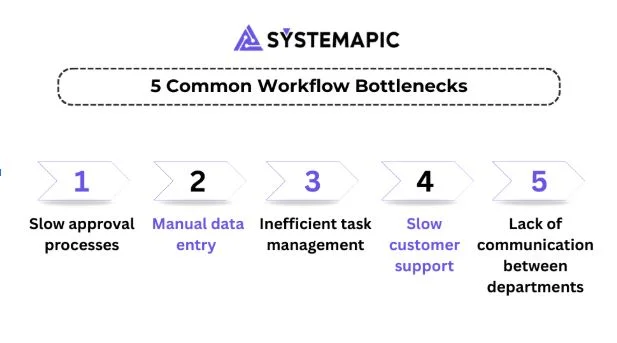
In today’s fast-paced digital world, businesses struggle with workflow inefficiencies that slow down productivity. At TheTechnoTrick, we understand how critical it is to streamline operations for better efficiency. Workflow bottlenecks can cause project delays, missed deadlines, and increased operational costs. However, automation offers a powerful solution to eliminate these barriers and enhance productivity.
Related:-
The Ultimate Guide to Warehouse Order Picking Secrets
Can We Start Investing at Any Age? Best Strategies Explained
How Custom Pens Can Elevate Your Corporate Gifts and Giveaways
How a Well-Stocked Building Material Store Can Save You Time and Money
Common Workflow Bottlenecks and Their Impact
Workflow bottlenecks occur when specific tasks or processes slow down the overall progress of a project. These inefficiencies lead to frustration, wasted resources, and decreased employee morale. Below are some of the most common workflow issues businesses face:
1. Manual Data Entry and Processing
One of the biggest workflow challenges is manual data entry. Employees spend hours inputting data into spreadsheets, increasing the chances of human error and slowing down operations.
How Automation Helps:
- Automated data processing tools can extract, validate, and organize data without human intervention.
- Reduces errors and enhances accuracy.
- Saves time, allowing employees to focus on strategic tasks.
2. Poor Communication and Collaboration
Miscommunication between teams can lead to confusion, errors, and project delays. Without proper collaboration tools, employees struggle to track progress and align their efforts.
How Automation Helps:
- Project management tools like Asana, Trello, or Monday.com automate task assignments and status updates.
- Real-time communication tools ensure smooth information flow across teams.
- Automated notifications keep everyone updated on important deadlines.
3. Approval Delays and Decision-Making Bottlenecks
Many businesses experience workflow delays due to slow approval processes. Whether it’s budget approvals or contract sign-offs, waiting for decision-makers can create major bottlenecks.
How Automation Helps:
- Workflow automation software streamlines approval requests by sending automatic reminders to decision-makers.
- E-signature tools allow stakeholders to approve documents instantly from anywhere.
- AI-driven analytics provide quick insights for faster decision-making.
4. Repetitive and Time-Consuming Tasks
Employees often waste valuable time performing repetitive tasks like scheduling meetings, responding to routine emails, or managing invoices.
How Automation Helps:
- Chatbots can handle FAQs, reducing the need for human intervention.
- Scheduling automation tools like Calendly eliminate back-and-forth emails.
- Automated invoicing systems speed up payment processes and reduce human errors.
5. Lack of Visibility into Workflow Progress
Without clear tracking systems, businesses struggle to monitor project statuses, leading to missed deadlines and inefficiencies.
How Automation Helps:
- Workflow tracking software provides real-time visibility into project progress.
- Automated reporting tools generate insights to identify process inefficiencies.
- Predictive analytics help optimize future workflows.
How Automation Enhances Business Productivity
By integrating automation, businesses can eliminate bottlenecks, increase efficiency, and boost overall productivity. Here are key benefits of workflow automation:
✅ Faster Task Completion: Automation speeds up repetitive processes.
✅ Reduced Human Errors: AI-driven tools ensure data accuracy.
✅ Improved Resource Allocation: Employees can focus on high-value tasks.
✅ Better Compliance & Security: Automated systems enforce data security policies.
✅ Seamless Integration: Modern automation tools integrate with existing business systems.
FAQs
Q1: What are the signs of a workflow bottleneck?
A: Some common signs include frequent task delays, increased employee frustration, high error rates, and excessive manual intervention in processes.
Q2: What are the best tools for workflow automation?
A: Popular automation tools include Zapier, HubSpot, Asana, Monday.com, Slack, and UiPath, depending on your business needs.
Q3: Can small businesses benefit from workflow automation?
A: Absolutely! Automation helps small businesses streamline operations, reduce costs, and compete effectively with larger enterprises.
Q4: Is automation expensive to implement?
A: While some automation tools require an investment, many affordable and scalable options exist, ensuring businesses of all sizes can benefit.
Q5: How do I start implementing automation in my workflow?
A: Begin by identifying bottlenecks, selecting the right automation tools, and gradually integrating them into your business processes.
Conclusion
Workflow bottlenecks can significantly impact productivity and efficiency, but automation provides a game-changing solution. By leveraging automated tools, businesses can eliminate delays, enhance collaboration, and improve overall performance. At TheTechnoTrick, we believe that embracing automation is the key to staying competitive in today’s fast-paced world. Start optimizing your workflow today and experience seamless business operations like never before!




